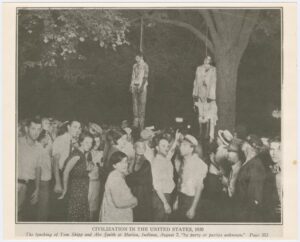by Sydney Southwick, dramaturg “This little light o’ mine, I’m goin’ let it shine. Let it shine, let it shine, let it shine”
BYU’s production of North Star begins with these lyrics from one of the most popular gospel songs in the world. Music has a special power to evoke all kinds of emotions from sadness to joy and fear to inspiration. Although literature and speech can do the same, music has impactful storytelling properties that cannot be found in any other medium. “Strange Fruit” is one of those songs. In 1937, Abel Meeropol wrote “Bitter Fruit” in response to a photo he saw of the lynching of Abe Smith and Tom Shipp in Indiana. Though he had not experienced the lynching in person, Abel was one of the many filled with sadness and rage at the racist assaults and murders that were continually committed against African Americans.

View of the lynching of Tom Shipp and Abe Smith at Marion, Indiana. Southern trees bear a strange fruit
Blood on the leaves and blood at the root
Black bodies swinging in the southern breeze
Strange fruit hanging from the poplar trees.
From “Bitter Fruit” by Abel Meeropol
Once Meeropol’s poem was set to music, “Strange Fruit” was ready for Billie Holiday to perform at the integrated jazz club, Café Society. At the end of her set, a single spotlight shone on her face, and all bar service was halted as she sang her haunting rendition to a silent room. Immediately after she finished, the audience seemed hesitant to clap. But the room was soon full of applause.

The song quickly became a staple of her sets, and she was met with both continued applause and racist harassment. The song became a symbol for the fight against racism in the Jim Crow South as it forced audience members to stare into the eyes of what was really happening in America. Still, many people were angry about the in-your-face, explicit nature of the song, perhaps brought on by the guilt of racist tendencies. Many believe that Billie’s inability to escape the song led to her eventual death. The racism that came with her performances ate at her every day.
She had grown sadly suited to capture the full grotesqueness of the song. Now, she not only sang of bulging eyes and twisted mouths. She embodied them.David Margolick, Strange Fruit: The Biography of a Song
The dramatic impact “Strange Fruit” had on those who heard it inspired other protest songs that were sung during the Civil Rights Movement. However, many of these songs are less explicit and focus on a message of pressing forward and standing strong in the face of racism. Ain’t gonna let nobody turn me around
I’m gonna keep on a-walkin’, keep on a-talkin’
Marchin’ up to freedom’s land
From the song “Ain’t Gonna Let Nobody Turn Me Around”
Listen for the Civil Rights music performed by the Bonner Family and members of the cast in BYU’s production of North Star on March 4-6 at 7:30 PM.
References Amoako, Aida. "Strange Fruit: The Most Shocking Song Of All Time?". Bbc.Com, 2019, https://www.bbc.com/culture/article/20190415-strange-fruit-the-most-shocking-song-of-all-time. Pak, Eudie. "The Tragic Story Behind Billie Holiday's "Strange Fruit"". Biography, 2020, https://www.biography.com/news/billie-holiday-strange-fruit.
Schomburg Center for Research in Black Culture, Photographs and Prints Division, The New York Public Library. "View of the lynching of Tom Shipp and Abe Smith at Marion, Indiana" The New York Public Library Digital Collections. 1930-10. https://digitalcollections.nypl.org/items/e614b4d0-434d-0132-798d-58d385a7b928
Schomburg Center for Research in Black Culture, Photographs and Prints Division, The New York Public Library. “Billie Holiday” The New York Public Library Digital Collections. 1935 – 1959. https://digitalcollections.nypl.org/items/bc290c77-e78a-0c57-e040-e00a1806687c
Schomburg Center for Research in Black Culture, Photographs and Prints Division, The New York Public Library. “View of the lynching of Tom Shipp and Abe Smith at Marion, Indiana” The New York Public Library Digital Collections. 1930-10. https://digitalcollections.nypl.org/items/e614b4d0-434d-0132-798d-58d385a7b928


